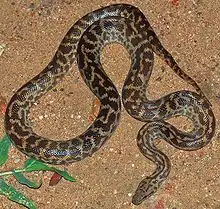Spotted python
The spotted python, eastern small-blotched python, or eastern children's python (Antaresia maculosa) is a python species found in northern Australia and New Guinea.[2] It is a popular pet among Australian reptile enthusiasts due to its small size and even temperament. No subspecies are currently recognized.[2][3]
| Spotted python | |
|---|---|
 | |
| Scientific classification | |
| Kingdom: | Animalia |
| Phylum: | Chordata |
| Class: | Reptilia |
| Order: | Squamata |
| Suborder: | Serpentes |
| Family: | Pythonidae |
| Genus: | Antaresia |
| Species: | A. maculosa |
| Binomial name | |
| Antaresia maculosa (Peters, 1873) | |
| Synonyms | |
| |
Taxonomy
Wilhelm Peters described the spotted python in 1873. A new subspecies, A. m. brentonoloughlini was described by Hoser (2003).[2] but this taxon is not considered valid by other herpetologists.[2][4][5] No subspecies of Antaresia maculosa are currently recognised.
Description
Adults average about 100–140 centimetres (39–55 in) in length. It has an irregular, blotched color pattern throughout its life. The blotches have ragged edges because the dark pigmentation occurs only on complete scales.[6][7]
Distribution and habitat
Found in Australia from the extreme north of the Cape York Peninsula, south through eastern Queensland to northern New South Wales. Also on many islands off the coast of Queensland. The type locality given is "Rockhampton, Port Mackay, Port Bowen [= Port Clinton]" [Queensland, Australia]. L.A. Smith (1985) restricted the type locality to "Port Mackay" (Mackay, Queensland, in 21° 09'S, 149° 11'E) by lectotype designation.[1] Antaresia maculosa has also been recorded from the southern Trans-Fly region of Papua New Guinea, at Weam in Western Province[8] and there are concerns it may be being exploited for the pet trade across the border in Indonesian West New Guinea.[9][10] Found in most types of habitats, but prefers rocky hillsides and outcrops with crevices and caves.[11] The Papua specimen was found behind discarded corrugated tin sheets beside a disused airstrip in Eucalypt savanna-woodland habitat dotted with numerous termite mounds.
Feeding
One of its favorite foods are the insectivorous bats that it catches at the entrance of their caves. Being the largest members of this genus, captive specimens will usually accept mice and other small rodents. Juvenile Spotted Pythons will usually feed on young lizards, mammals and the occasional amphibian.[12]
 Spotted Pythons are often mistaken for the Children's python
Spotted Pythons are often mistaken for the Children's python
Reproduction
The spotted python is oviparous, with females laying up to 15 eggs in a clutch.
References
- McDiarmid, R.W., J.A. Campbell & T.Touré 1999. Snake Species of the World: A Taxonomic and Geographic Reference, vol. 1. Herpetologists' League. 511 pp. ISBN 1-893777-00-6 (series). ISBN 1-893777-01-4 (volume).
- Antaresia maculosa at the Reptarium.cz Reptile Database. Accessed 20 November 2017.
- "Antaresia maculosa". Integrated Taxonomic Information System. Retrieved 18 September 2007.
- Schleip, W. & M. O’Shea (2010). "Annotated checklist of the recent and extinct pythons (Serpentes, Pythonidae), with notes on nomenclature, taxonomy, and distribution". ZooKeys (66): 29–79. doi:10.3897/zookeys.66.683. PMC 3088416. PMID 21594030.
- Kaiser, H.; B.I. Crother; C.M.R. Kelly; L. Luiselli; M. O'Shea; H. Ota; P. Passos; W. Schleip & W. Wüster (2013). "Best Practices: In the 21st Century, Taxonomic Decisions in Herpetology are Acceptable Only When Supported by a Body of Evidence and Published via Peer-Review". Herpetological Review. 44 (1): 8–23.
- "NOTES ON ANTARESIA MACULOSA (SPOTTED PYTHON)" (PDF).
- "Spotted Python (Antaresia maculosa) | ReptileTalk NET". ReptileTalk NET. 2016-05-08. Retrieved 2017-11-19.
- O’Shea, M.; R.G. Sprackland & I. Bigilale (2004). "First record for the genus Antaresia (Squamata: Pythonidae) from Papua New Guinea". Herpetological Review. 35 (3): 225–227.
- Natusch, D.J.D. & J.A. Lyons (2011). "The harvest of Antaresia maculosa (Pythonidae) from West Papua, New Guinea". Herpetological Review. 42 (4): 509–511.
- Natusch, D.J.D. & J.A. Lyons (2012). "Exploited for pets: the harvest and trade of amphibians and reptiles from Indonesian New Guinea". Biodiversity and Conservation. 21 (11): 2899–2911. doi:10.1007/s10531-012-0345-8.
- Barker, D.G. & T.M. Barker 1994. Pythons of the World Vol.1 Australia. The Herpetocultural Library. xviii + 171 pp. ISBN 1882770277.
- "Spotted Python Care Sheet - Antaresia Pythons". Reptile Range. Retrieved 2 April 2020.
Further reading
External links
| Wikimedia Commons has media related to Antaresia maculosa. |
- Spotted Python (Antaresia maculosa) at Antaresia.com. Accessed 18 September 2007.
- Spotted Python Care Sheet Accessed 27/10/2011

